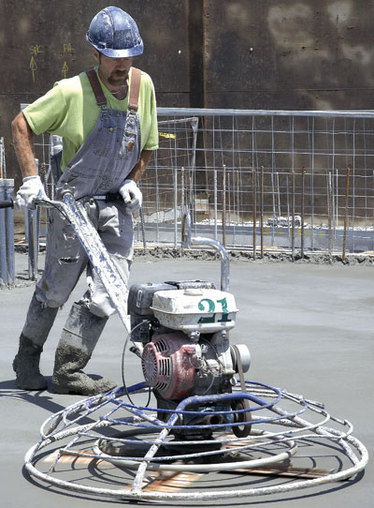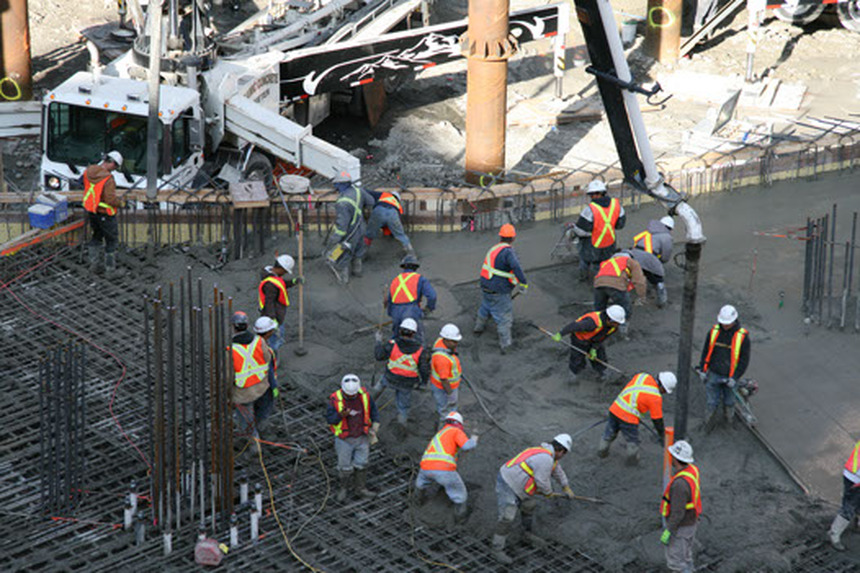Work Doesn't Have to Be Deadly (Part 2)
In part one, I told the story of a co-worker, a truck driver, who died working on the job.
A few years later, I was working in construction when another a co-workers died on the job.
My trucking career actually helped me get into construction, because being a material handler with a commercial drivers license was considered an asset.
I found out how dangerous sheet metal work could be one day soon after I was hired, when I returned to our shop from a delivery, I noticed that rescue vehicles were on scene. An apprentice had been working with a journeyman on a press brake bending thick metal stock. The apprentice, wanting to be sure he was on his mark, had his head over the metal and when the die hit, the metal slammed upward, broke his jaw, and severed a vein in his neck. A week later he returned to work -- afraid he would be fired.
I was a field hand and I loved the big construction jobs. I was working on an eleven-story construction site on one of the top floors, when the sound of sirens approaching the site got our attention. You have mixed feelings hearing that sound on a construction site. Yes, it means help is on the way, but you also know someone you have been working with has been injured well beyond the scope of first aid.
We had been working on a large, continuous concrete pour like the one in the picture below:
A few years later, I was working in construction when another a co-workers died on the job.
My trucking career actually helped me get into construction, because being a material handler with a commercial drivers license was considered an asset.
I found out how dangerous sheet metal work could be one day soon after I was hired, when I returned to our shop from a delivery, I noticed that rescue vehicles were on scene. An apprentice had been working with a journeyman on a press brake bending thick metal stock. The apprentice, wanting to be sure he was on his mark, had his head over the metal and when the die hit, the metal slammed upward, broke his jaw, and severed a vein in his neck. A week later he returned to work -- afraid he would be fired.
I was a field hand and I loved the big construction jobs. I was working on an eleven-story construction site on one of the top floors, when the sound of sirens approaching the site got our attention. You have mixed feelings hearing that sound on a construction site. Yes, it means help is on the way, but you also know someone you have been working with has been injured well beyond the scope of first aid.
We had been working on a large, continuous concrete pour like the one in the picture below:
You need a lot of people to pump, spread, and finish the concrete. It is a major operation on a large construction site because, as the concrete is poured, the chemical reaction of hardening and setting up happens very quickly, so you have to work fast. Later, when the concrete sets, core tests are done. If the concrete hasn't cured correctly it will be a bad day on the site. A failed pour requires removal and re installation. It is expensive and time consuming -- and usually the concrete contractor is responsible for that cost.
On this day the pour was finished and the workers were using power trowels to finish. The motor on this device is powerful and requires strength to hold onto the machine, keeping it level and under control. On this particular day, the finish laborer had his machine close to the edge of the structure.
On this day the pour was finished and the workers were using power trowels to finish. The motor on this device is powerful and requires strength to hold onto the machine, keeping it level and under control. On this particular day, the finish laborer had his machine close to the edge of the structure.

The trowel blade struck a piece of rebar. The blades stopped, and the sudden rotation of the handle threw the worker off the side of the building. Later, we learned he had died.
All multi-floor sites have a steel rope railing installed before workers are allowed on them. This floor had that safety device in place. The worker was thrown through it.
Where was his fall protection?
At this phase of a large job there are hundreds of workers on the site every day. I didn't know this worker personally. I looked over the edge of the building as the emergency vehicles left and remember feeling sad, but went right back to work, grateful it wasn't me.
Are deaths in the workplace inevitable?
When the Hoover Dam was constructed, 96 worker deaths were defined as “industrial fatalities.” (By the way, the story that workers fell into the concrete and were left as the pour continued are urban legend.)
In my former jobs in construction and trucking, (two of the top ten most dangerous occupations), I was around when two deaths occurred. Neither of the workers was inexperienced. My trucker friend’s failure to use his seatbelt use was a factor in his death. The concrete laborer's machine came too close to the edge of the building, and coming into contact with the rebar contributed to his death.
But there were also systemic issues -- some seen and some unseen -- that were in play and contributed to these tragic outcomes. Neither of these men needed to die.
4.383 people died on the job in 2012. As safety professionals, we owe their families an in-depth analysis into the causes of these deaths, and all workplace accidents. Our job is to ensure that 4,383 -- or even 2 -- people dying at work is never an acceptable number.
All multi-floor sites have a steel rope railing installed before workers are allowed on them. This floor had that safety device in place. The worker was thrown through it.
Where was his fall protection?
At this phase of a large job there are hundreds of workers on the site every day. I didn't know this worker personally. I looked over the edge of the building as the emergency vehicles left and remember feeling sad, but went right back to work, grateful it wasn't me.
Are deaths in the workplace inevitable?
When the Hoover Dam was constructed, 96 worker deaths were defined as “industrial fatalities.” (By the way, the story that workers fell into the concrete and were left as the pour continued are urban legend.)
In my former jobs in construction and trucking, (two of the top ten most dangerous occupations), I was around when two deaths occurred. Neither of the workers was inexperienced. My trucker friend’s failure to use his seatbelt use was a factor in his death. The concrete laborer's machine came too close to the edge of the building, and coming into contact with the rebar contributed to his death.
But there were also systemic issues -- some seen and some unseen -- that were in play and contributed to these tragic outcomes. Neither of these men needed to die.
4.383 people died on the job in 2012. As safety professionals, we owe their families an in-depth analysis into the causes of these deaths, and all workplace accidents. Our job is to ensure that 4,383 -- or even 2 -- people dying at work is never an acceptable number.

